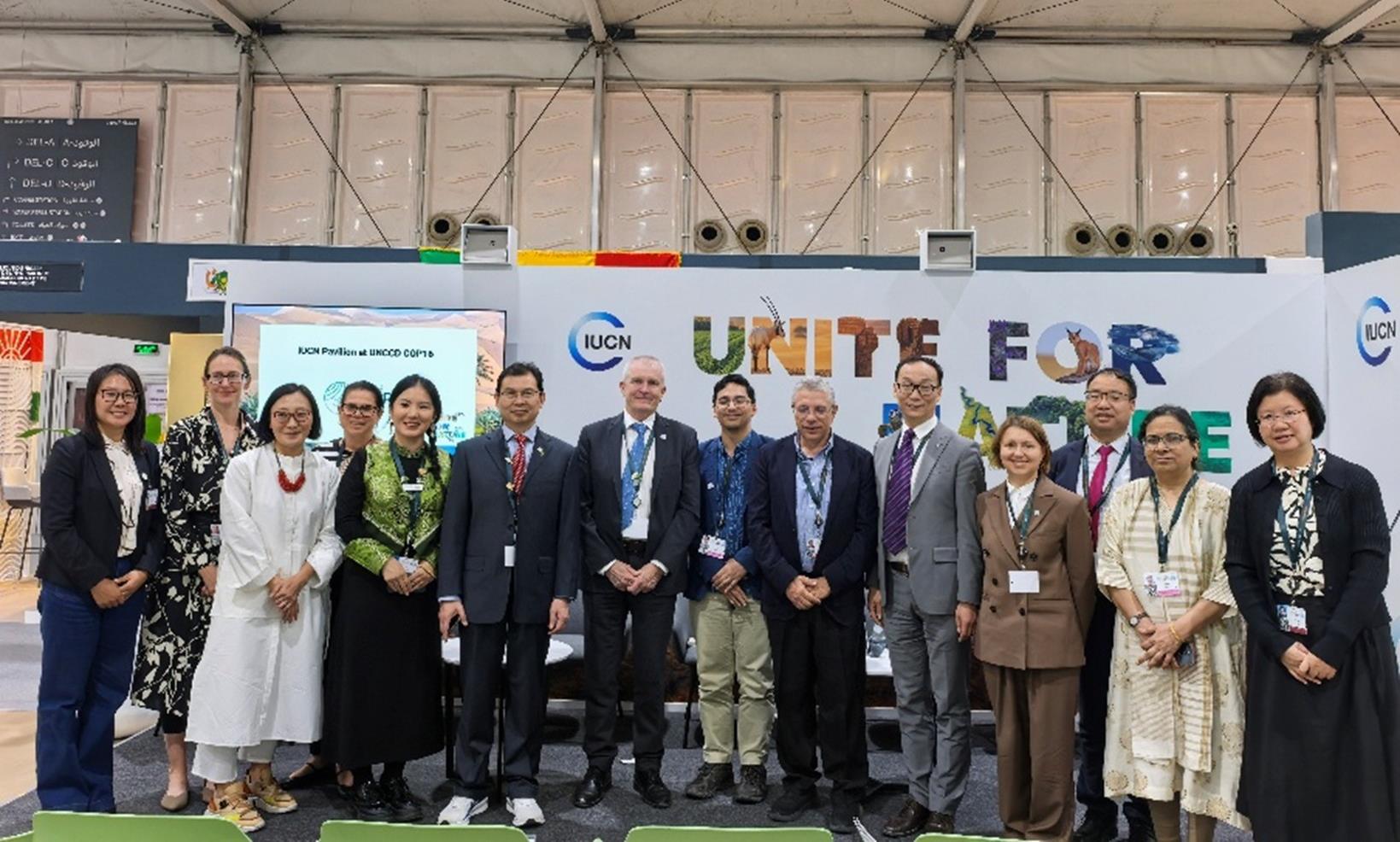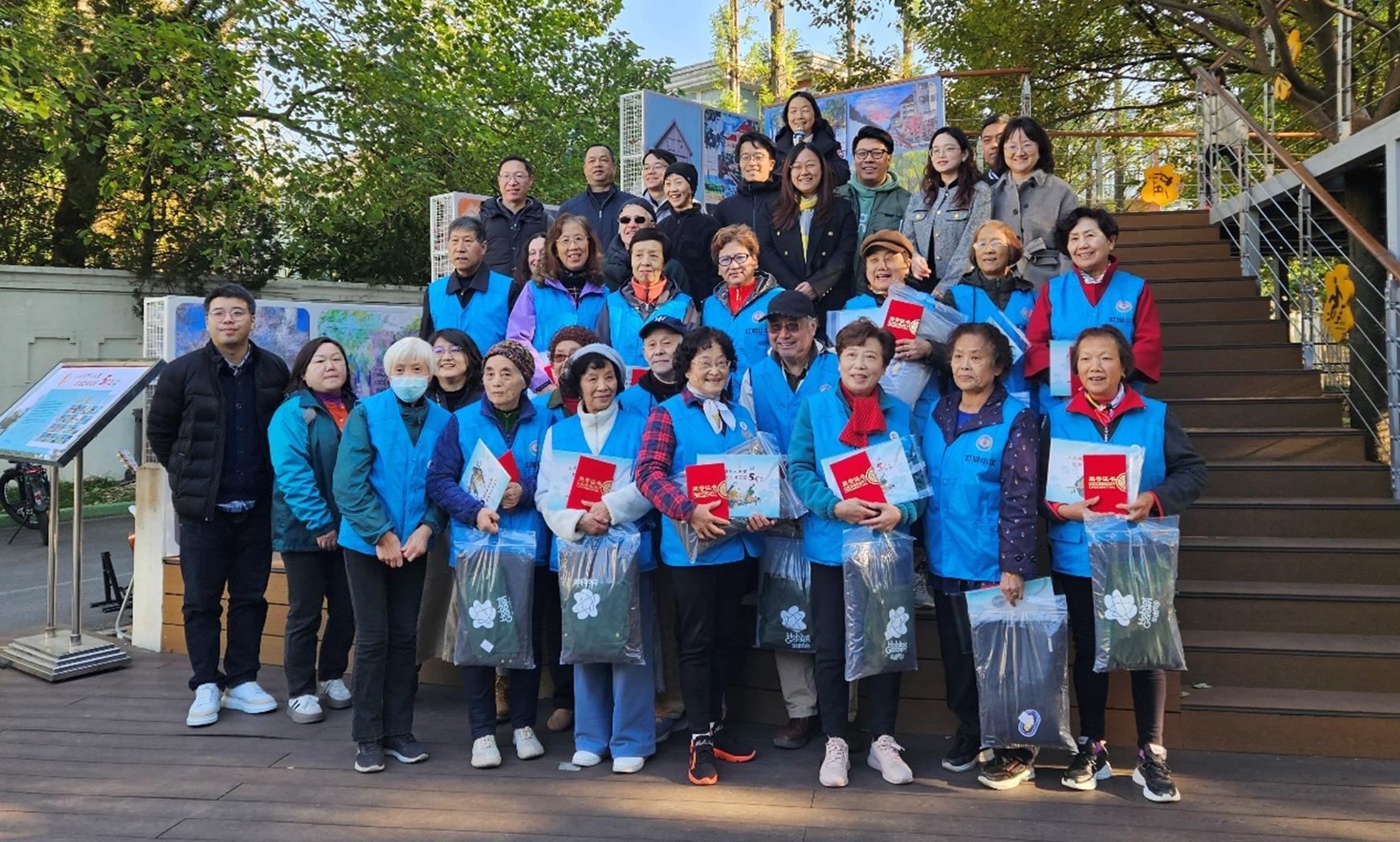Accelerating the Restoration of our Planet: 2024 Major Milestones of TNC China
- 日期:2025.01.07
- |
- 来源:tnc
The escalating climate and biodiversity crises are causing increasingly severe consequences—ecosystem degradation, extreme temperatures, devastating floods, historic wildfires, global food shortages and more. Achieving our 2030 goals is more crucial than ever before. We must unite our efforts to overcome these challenges and remain steadfast in pursuit of our objectives. In 2024, we continued to advance multiple nature conservation initiatives that support local communities, governments of all levels and businesses to address and solve pressing environmental issues. Guided by our core approach of “science+ empowerment+ action”, we are trusted advisors to governments, the private sector, and other organizations. By leveraging the strengths of an international conservation organization and collaborating with partners across sectors, we work with nature to tackle humanity’s greatest challenge.
Climate

The kick-off meeting for the project “Research on Financing Mechanisms for Nature-Based Climate Change Solutions”; Image Source: Yuan Mingjia/TNC

The kick-off meeting of the “Research on China Climate Change Adaptation Indicators” project;Image Source: Peng Yunyue/TNC
Following the signing of a Memorandum of Understanding (MoU) with the National Center for Climate Change Strategy and International Cooperation (NCSC) in 2023, the kick-off meeting of two key projects—“Research on Financing Mechanisms for Nature-Based Climate Change Solutions” and “Research on China Climate Change Adaptation Indicators”—was held in Beijing on 29 March. By the end of December, the Financing Mechanisms project analyzed publicly available national data and conducted case studies in Guangxi, Chongqing and Yunnan. Subsequently, a thematic workshop was held to discuss findings. Meanwhile, the Adaptation Indicators project developed national-level adaptation indicators, established a provincial-level indicator system and completed case evaluations. Efforts to extend this work to the city level are currently underway.
Our Efforts in Inner Mongolia

The completion ceremony of the “Inner Mongolia Shengle International Ecological Demonstration Zone Project” was held in Hohhot. Image Source: China Green Carbon Foundation

The Inner Mongolia Shengle International Ecological Demonstration Zone Project; Image Source: Shan Liang/TNC
Against the backdrop of climate change, we continue to explore the “Restoration by Design” model by developing ecological restoration and sustainable development initiatives tailored to arid and semi-arid regions in Horinger. The Shengle International Ecological Demonstration Zone has been transformed into a comprehensive nature education base with a primary focus on carbon sequestration. In partnership with organizations such as the Inner Mongolia Daqingshan National Nature Reserve, we have also initiated a series of nature education activities. Our efforts centered on refining eight key aspects of the systematic restoration project: planning, restoration, management, development, climate change adaptation, community engagement, training and education, and monitoring and evaluation. The efforts aim to create a holistic and replicable restoration model that can provide guidance for similar efforts in other regions. On 15 October, the completion ceremony for the “Inner Mongolia Shengle International Ecological Demonstration Zone Project” was held in Hohhot, co-hosted by the China Green Carbon Foundation and the Inner Mongolia Forestry and Grassland Administration, with support from the Inner Mongolia Lao Niu Foundation and TNC. After over a decade of dedicated work, the Shengle project successfully completed its construction phase and the first management and maintenance period. During the construction phase, 2,355 hectares of forest were planted, with a survival rate over 80%. Over 3 million trees and shrubs of various species such as Chinese pine, Mongolian scots pine, spruce, Siberian elm and wild apricot were planted. The number of plant species in the area increased from less than 30 to over 80 species. The project can prevent 25,000 tons of soil erosion annually, significantly improving soil and water retention with the latter rising from 4 million to 5.3 million tons. Additional, the project is expected to sequester 220,000 tons of carbon dioxide over the next 30 years, with 160,000 tons having already been purchased by Disney.

A comparison between the experimental pasture of East Ujimqin Banner (Dong Wuzhumuqin Qi) and the neighboring herders’ pastures: On the left is the demonstration site, and on the right is the traditional herders’ pasture along with the electric fences they use. (Photography: Lin Kuocheng/TNC)
The TNC China Inner Mongolia Grassland Smart Management Project is being implemented in the Ewenki Autonomous Banner of Hulunbuir, the East Ujimqin Banner of Xilingol League and the Siziwang Banner of Ulanqab City. In Siziwang Banner, the hydroponic grass factory has been running continuously for over 900 days, producing 1 ton of fresh grass per day to feed 400 ewes. During the rest grazing period, 12,000 acres of grassland are allowed to recover, yielding excellent results as a demonstration project.
Forest Ecological Restoration Demonstration and Practice

Ant Forest Multiple Benefits Forest Restoration Project at Tianchi, Yunlong county of Yunnan Province; Image Source: Zhao Mingshi/TNC
With the support of Ant Forest and TNC’s “Plant a Billion Trees” initiative, we are restoring key Yunnan snub-nosed monkey habitat in northwest Yunnan. In 2024, we expanded the restoration area by 4,100 mu across Yunlong, Lanping and Weixi counties, planting 428,000 trees, including pine, spruce and fir. To date, approximately 1,400 mu of habitat restoration has been completed. As scientific advisors, we collaborated with Hainan University to complete a feasibility study for the early-stage carbon sink project in the mangrove forests of Danzhou, Hainan. Moving forward, we will continue to advance the 373-hectare abandoned fishpond restoration project in Danzhou into a carbon project under the International Voluntary Carbon Standard.
Resilient Greater Bay Area

On 24 September, an international seminar focusing on climate change and building a resilient Greater Bay Area was held in Shenzhen. Image Source: TNC

From 26-27 October, the annual training camp of the “Together for a Better City” youth climate action initiative was held at the Shenzhen-Hong Kong Innovation and Technology Cooperation Zone in Futian, Shenzhen.Zhang Xunyu, Project Manager of Shenzhen Project, shared insights and engaged in discussions. Image Source: TNC
A region highly vulnerable to coastal climate risks, the Guangdong-Hong Kong-Macao Greater Bay Area (GBA), is a significant demonstration area for climate adaptation. In May 2024, Shenzhen was selected as a national pilot city for advancing climate resilient cities. To support this work, we collaborated with government agencies, think tanks and enterprises to implement a comprehensive approach spanning four key phases: risk assessment, design, implementation and evaluation. These efforts aim to position Shenzhen as a leading model for climate resilience and innovation. In June, in partnership with the Shenzhen Urban Planning and Design Institute, we developed a framework to spatialize and quantify climate vulnerability across the city. This work forms the basis for future climate-resilient community development in Shenzhen, offering actionable insights and strategic guidance. On 24 September, an international seminar focusing on climate change and a resilient GBA was successfully held in Shenzhen. Participants included representatives from NCSC, the Shenzhen Municipal Ecology and Environment Bureau, Central University of Finance and Economics, China Academy of Urban Planning and Design, Urban Planning and Design Institute of Shenzhen, Hong Kong University of Science and Technology, Shanghai Jiao Tong University, TNC’s Global, Asia Pacific, California and New York teams, as well as Tencent’s Social Sustainable Value Division. Attendees discussed the significance of urban resilience in the face of climate change and pathways to achieve it. To further enhance the synergy between coastal habitat restoration and disaster risk reduction, we held a seminar on coastal disaster mitigation with conserving and restoring coastal habitats in partnership with the Second Institute of Oceanography under the Ministry of Natural Resources on 9 December in Shanghai. Throughout the year, we also engaged young audiences with a series of climate change education programs. Using a “small hands holding big hands” approach, these activities aimed to to inspire broader public participation in climate adaptation efforts.
Shanghai Habitat Garden

On 29 November, the Hongxu Habitat Garden in Changning District, Shanghai, celebrated its fifth anniversary. Image Source: TNC

Habitat Museum; Image Source: Pengpai News
Since the opening of the first habitat garden in 2019, the Shanghai Habitat Garden project has completed 27 habitat gardens in Changning District, covering communities, commercial areas as well as primary and secondary schools. These efforts have gradually established a demonstration network of habitat gardens in the district, steadily advancing toward the goal set in Changning District’s 14th Five-Year Plan to create no fewer than 30 habitat gardens by 2025. In May, habitat gardens were formally incorporated intothe Shanghai Biodiversity Conservation Strategy and Action Plan (2024–2035)as a nature-based solution to enhance the ecosystem services provided by urban green spaces. And on 22 May, with our support, the Habitat Museum was officially opened. Spanning 600 square meters of indoor exhibition space, the museum features engaging interactive exhibits and thousands of plant and animal specimens, showing the expansive story of Shanghai’s habitat gardens. In September, the first habitat garden in Pudong was initiated in the Dong’an (East Bund) Project in Shanghai. As Pudong’s first wetland habitat garden in urban public spaces, the project aims to demonstrate urban micro-wetland habitats, native plant landscapes, cost-effective plant groupings for diverse public green spaces and low-maintenance management practices, offering a comprehensive model for urban ecological improvement.
Protect
National Parks

Giant Panda National Park - Dujiangyan Area; Image Source: Li Jianyu/TNC
Since 2021, TNC has been collaborating with Institutes of Science and Development, Chinese Academy of Sciences, on the “Research on Key Institutions for Multi-Stakeholder Participation in China’s National Parks from a Governance Perspective” project. Building upon previous research, the special issue of “Modernizing National Park Governance System” was published in the second issue ofBulletin of Chinese Academy of Sciencesin February 2024. Curated by Professor Huang Baorong of Institutes of Science and Development, Chinese Academy of Sciences, this issue offers a comprehensive analysis of critical topics such as the theoretical foundation and pathways for deepening reforms in the construction of a modern governance system for national parks in China, drawing on international best practices, as well as frameworks for scientific decision-making and advisory mechanisms.
Our Efforts in Sichuan Province

On 9 April, the Sichuan Provincial Forestry and Grassland Bureau (Giant Panda National Park Sichuan Provincial Bureau) held a symposium in Deyang on the protection and development of small panda populations in the Giant Panda National Park. Ni Jiubin, Director of TNC China Program Southwest Center and Secretary-General of the Giant Panda Small Population Conservation Alliance, presented the “Work Report of the Giant Panda Small Population Conservation Alliance.”; Image Source: TNC

Image Source: Yin Le
On 9 April , the Sichuan Provincial Forestry and Grassland Bureau (Sichuan Provincial Administration Bureau of Giant Panda National Park) held a seminar in Deyang focused on the protection and development of small giant panda populations within the Giant Panda National Park. Representatives at the meeting exchanged in-depth discussions on the practices and experiences related to small population conservation, offering valuable insights for the establishment and development of the Giant Panda Small Population Conservation Alliance. A consensus was reached, and participants agreed to work together to advance the high-quality development of the Giant Panda National Park. In 2024, in the “core area” of the Giant Panda’s small populations—the Deyang section of the Giant Panda National Park—we continued our partnership with Sungrow Power Group to carry out a habitat restoration project covering 100 acres. We also carried out a research project on artificial nests for wild panda where we constructed 10 artificial nests and advanced scientific conservation efforts for small panda populations. The “3000+ Giant Panda National Park Patrol Personnel Comprehensive Skills Training Program” is a collaborative project launched by the Sichuan Provincial Forestry and Grassland Bureau(Sichuan Provincial Administration Bureau of Giant Panda National Park)and TNC in 2023. The training program has garnered widespread support from various levels of management within the Sichuan Provincial Administration Bureau of Giant Panda National Park and has been widely embraced by the patrol personnel. To date, five training sessions have been held, with 333 in-person participants and over 1,000 online participants.

In November, staff from the DeyangAdministration Bureauof Giant Panda National Park were pleasantly surprised when they were sorting the latest monitoring data from infrared cameras. They discovered photos of a wild giant panda visiting the artificial “panda nest” that was built in the Dazhangshu area of Mianzhu last year. Image Source: the DeyangAdministration Bureauof Giant Panda National Park
Our Efforts in Yunnan Province

Joint Biodiversity Patrol and Protection in Laojun Mountain by Multiple Departments; Image Source: Li Xueru
As scientific advisors, we continued to empower the local team at the Lijiang Laojun Mountain Yunnan snub-nosed monkey Conservation Area over the past year. We helped enhance the organizational structure of local institutions and strengthen their fundraising capabilities. As one of the main initiators of the Yunnan snub-nosed monkey range-wide conservation Network, we have been actively involved in and supported the network’s operations over the year. The 4th and 5th Annual Conferences of the Yunnan snub-nosed monkey range-wide conservation Network were held in Kunming and Dali Yunlong, Yunnan, in January and November 2024, respectively. TNC will assume the role of rotating chair for the network’s 5th term in 2025.
Our Efforts in Beijing

Forest Management Demonstration Area of Wuzuolou Forest Farm;Image Source: Du Qing/TNC

The White-naped Cranes in the Demonstration Area;Image Source: Song Huiqiang
To advance multifunctional forest management, along with our partners, we completed baseline biodiversity surveys and established a close-to-nature forest management demonstration site, covering 800 acres at Wuzuolou Forest Farm. We also conducted monitoring and evaluation of management outcomes and engaged in research on multifunctional forest management practices. To enhance bird habitats around Miyun Reservoir, we worked with partners to complete the first-year implementation, monitoring and evaulation of a 200-acre, bird-friendly farmland management demonstration area in Xiaocao Village, Taishitun Town. Additionally, we collaborated on studies aimed at optimizing bird habitats in the reservoir area. Preliminary monitoring results from the Xiaocao Village bird-friendly farmland demonstration revealed a notable increase in farmland bird diversity compared to the same period in previous years. Five nationally Class I protected bird species were recorded (the White-naped Crane, Hooded Crane, Great Bustard, White-tailed Eagle and Black Stork) along with 19 nationally Class II protected species. These preliminary findings highlight the initial success of the demonstration and provide a scientific foundation for future demonstration efforts.
Our Efforts in Dongying, Shandong Province

Both parties signed a Memorandum of Cooperation. Image source:TNC
On 12 November, the “Along the Yellow River to Meet the Sea” 2nd International Yellow River Estuary Bird Watching Season was launched in Dongying, Shandong. On the same day at the event, TNC and the Administration of the Shandong Yellow River Delta National Nature Reserve signed a memorandum of cooperation, outlining their intention to collaborate on international wetland conservation efforts in the Yellow River Delta region of Dongying over the next three years. The signing of this memorandum of cooperation marks the beginning of a long-term, stable partnership between the two parties to focus on biodiversity conservation, tackle climate change and advance the innovative development of socially driven protected areas.
Healthy Rivers

Heishui River Project Discussion; Image Source: TNC
Over the past year, we conducted extensive discussions with the Shanghai Investigation, Design & Research Institute (China Three Gorges Corporation) on the optimization of dam removal for the three dams on the Heishui River. These discussions also covered adaptive management based on monitoring and assessment, as well as the restoration and long-term protection of fish habitats after the dam removal. A cooperation framework for the project has been established. Additionally, we have partnered with the Institute of Hydrobiology, Chinese Academy of Sciences, to explore a pilot project for fish habitat restoration in the Chishui River Basin. We also engaged in discussions with the National Nature Reserve for Rare and Endemic Fish Species in the Upper Yangtze River to address key challenges in current conservation efforts and have developed an action plan for future collaboration.
Provide
Resilient Watershed: Projects in Zhejiang Province

Jiande City Hangchuan Village Wetland Restoration Project;Image Source: Qiandao Lake Water Fund
Building on watershed analysis and field research, the Qiandao Lake Resilient Watershed Project (Qiandao Lake Water Fund) acted as scientific advisors and collaborated with partners to develop strategies for restoring watershed resilience and controlling non-point source pollution. These strategies focusd on sustainable agricultural practices (source reduction) and wetland restoration (process interception). After years of trials and research, the team identified effective measures with prevention potential and scalability. A best management practices manual for rice farming has also been compiled. In addition to reducing pollutants at the source, the project is restoring wetlands in Xiaowudu, Qidu and Hangchuan Village by intercepting and treating pollutants from agricultural runoff and rural domestic wastewater. The project also explores market-based, diversified ecological compensation mechanisms supported by national policies and has formed strong partnerships with both domestic and international companies, including Starbucks, Microsoft, Disney and Zhejiang Construction Group, to advance innovative “water replenishment” practices.

On 11 October, the “Shouchang Resilient Watershed Stewardship Committee” was officially established at the ecological wetland in Hangtou Town, Jiande City, Zhejiang Province. With the support of the Zhejiang Qiandao Lake Water Fund, the initiative aims to enhance collaborative governance of the Shouchang River Basin’s water environment, promote ecological restoration and biodiversity conservation and contribute to rural revitalization. Image Source: Water Fund
Sustainable Agriculture

The 3rd Huang-Huai-Hai Region Winter Wheat Conservation Tillage Technology Exchange and Field Observation Event; Image Source:TNC
During the winter wheat growing season from October 2023 to June 2024, TNC and our partners implemented regenerative agriculture practices across approximately 1,032 hectares across the North China Plain, China’s largest winter wheat production area. More than 3,000 participants were trained through this dedicated program. Early adopters played a key role in encouraging neighboring farmers to adopt regenerative practices, while professional soil health training sessions have improved local farmers’ understanding of both the theory and practical application of soil health. We are also working closely with stakeholders across the agri-food value chain to develop systemic incentive mechanisms aimed at driving a sustainable transformation of the agri-food system. Tailored to the unique geographic and ecological characteristics of different regions and farming systems, we co-established the Yellow Earth Conservation Tillage Alliance with value chain partners. We also organized the 3rd Huang-Huai-Hai Region Winter Wheat Conservation Tillage Technology Exchange and Field Observation Event, as well as soil health talent development programs.
Policy Advocacy and Public Participation

Will McGoldrick delivered a speech at the China Council for International Cooperation on Environment and Development (CCICED);Image Source:CCICED

Linda Krueger delivered a speech at the China Council for International Cooperation on Environment and Development (CCICED);Image Source:CCICED
In 2024, the China Council for International Cooperation on Environment and Development (CCICED) launcheda special policy study on “Biodiversity Conservation and Implementation of the Kunming-Montreal Global Biodiversity Framework” (Biodiversity SPS). The research is undertaken by the Satellite Environment Application Center of the Ministry of Ecology and Environment (MEE), the Nature Positive Initiative and TNC. The research project is led on the Chinese side by Gao Jixi, Chief Scientist at the Satellite Application Center of the Ministry of Ecology and Environment. On the international side, Marco Lambertini, Convenor of the Nature Positive Initiative, and Linda Krueger, TNC Director of Biodiversity and Infrastructure Policy, serve as co-leaders. On the morning of 11 October, the Open Forum for CCICED 2024 Annual General Meeting of CCICED, titled “Promoting Harmony with Nature to Implement the Kunming-Montreal Global Biodiversity Framework,” was held at the Diaoyutai State Guesthouse in Beijing. In the “Ecological Conservation Models for the 30x30 Target” discussion, Mr. Will McGoldrick, Managing Director of TNC Asia Pacific, shared three key points regarding the critical 30x30 target of the Kunming-Montreal Global Biodiversity Framework. Meanwhile, Linda Krueger moderated the second session titled “Mobilization of Funding and Resources for the Kunming-Montreal Global Biodiversity Framework” and provided the closing summary of the forum. From 21 October to 1 November, the 16th meeting of the Conference of the Parties to the United Nations Convention on Biological Diversity (CBD COP 16) was held in Cali, Colombia, with the theme of “Peace with Nature”. TNC representatives attended and actively engaged in discussions on biodiversity conservation models, mainstreaming, resource mobilization and biodiversity-climate synergy, sharing TNC’s global experiences and practical cases.
.
TNC China Representative Receives Case Certificate; Image Source: Shan Shui Conservation Center
On 25 October, during the side event titled “Exploring Voluntary Commitments by Non-State Actors in Advancing Other Effective Area-Based Conservation Measures (OECMs): Insights from China and International Perspectives,” TNC China’s projects, including the Miyun Reservoir Watershed Xiaocao Village Bird Habitat Case, the Qingshan Village Water Source and Biodiversity Conservation Area Case, and the “Jianghehui·Zhejiang Cui” Siwuling Nature Site Case, were recognized as shortlisted potential OECM cases in China.
From 11-24 November, the 29thmeeting of Conference of the Parties to the United Nations Framework Convention on Climate Change (COP29) was held in Baku, the capital of Azerbaijan. TNC representatives attended the event and participated in activities and exchanges to share TNC’s perspectives, practices and recommendations.
From 2-13 December, the 16th meeting of the Conference of the Parties to the United Nations Convention to Combat Desertification (UNCCD COP16) was held in Riyadh, the capital of Saudi Arabia. TNC representatives attended and actively participated in relevant activities and exchanges, sharing TNC’s perspectives, practices and recommendations.
Together with our partners, we also held two side events during the conference: "Valuing Grasslands: Critical Ecosystems for Nature, Climate and People" and " Restoring Degraded Grasslands to Combat Desertification in Dry Areas". The events promoted TNC's work in comprehensive ecological restoration, sustainable management and community cooperation.

Wetland Conservation Network Training Site; Image Source:Jia Yue/TNC
From 22-24 July, the Wetland Conservation Network Training was held in the Aba Tibetan and Qiang Autonomous Prefecture of Sichuan Province. Approximately 100 participants attended, including representatives from the National Forestry and Grassland Administration, Wetland Network member organizations, research institutes and social organizations. During the event, Peng Yunyue, Science Specialist at TNC China, and Li Qian, TNC Henan Program Conservation Director, delivered presentations on “Innovations and Practices in International Wetland Governance” and the case study of “Ecological Conservation and Restoration of ‘Mountains, Rivers, Forests, Farmlands, Lakes, and Grasslands’—Danjiang Wetland (2019-2022).”

Image Source:Shan Liang /TNC
From May to July, we partnered with the Asian Infrastructure Investment Bank (AIIB) to jointly hold the “Nature Beyond Nature” urban and biodiversity photo exhibition at AIIB’s headquarters office in Beijing. The fate of humanity is closely intertwined with the biodiversity of the surrounding environment. Only by integrating the concept of ecological protection into our daily activities and actions can humans and nature coexist harmoniously long term and benefit humanity itself.
On 13 June, the Ministry of Natural Resources of the People’s Republic of China released the “Announcement on the List of Winners for the 2024 Natural Resources Science Popularization and Explanation Competition, Science Popularization Micro-Video Competition, and Outstanding Popular Science Books.” The “Talk about Coastal Habitats” submitted by TNC was selected as one of the “2024 Excellent Popular Science Micro-Video Works on Natural Resources.”
The world is facing a global crisis, and the time we have to address these challenges may be shorter than we think. In the future, we hope everyone will join us in taking a shared responsibility for the fate of humanity—by loving and protecting nature—so that our blue planet can enjoy a more sustainable and prosperous future for all.




